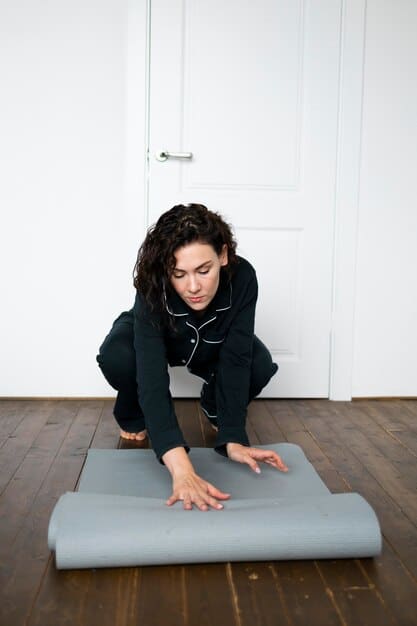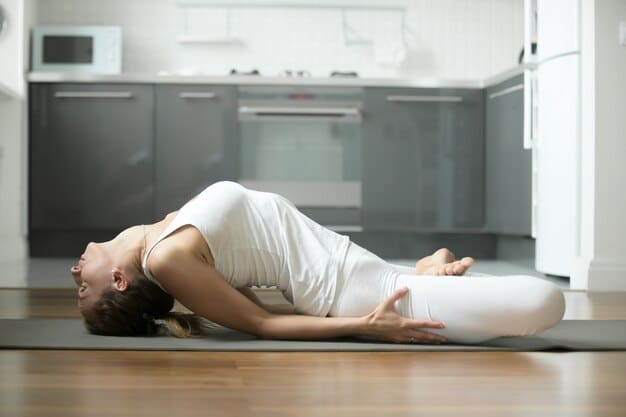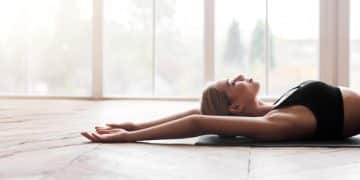Yoga for Stress: 5 Mindful Movement Poses for Relief

Through mindful movement, yoga offers a powerful pathway to alleviate stress, fostering a deeper connection between body and mind, and promoting inner calm through specific poses and breathing techniques.
In our increasingly fast-paced world, finding moments of tranquility and effective strategies for stress reduction is more crucial than ever. Many of us seek holistic approaches that address both our physical and mental well-being. This is where the profound practice of yoga steps in, offering a sanctuary of calm and a path to holistic well-being. This article will help you to Discover the Power of Mindful Movement: 5 Yoga Poses for Stress Relief, providing practical insights into how these ancient techniques can transform your daily life.
the transformative power of mindful movement
Mindful movement, a core principle of yoga, goes beyond mere physical exercise; it encourages a deep, conscious connection between your body’s actions and your mind’s awareness. This intentional engagement can be particularly potent in mitigating the impacts of daily stress. By bringing your attention fully to each breath and every movement, you create a dedicated space away from life’s incessant demands, allowing your nervous system to regulate and your mind to quiet.
Understanding mindful movement involves recognizing that it is not simply about going through the motions. Instead, it is about cultivating presence. When practicing yoga with mindfulness, you are invited to observe sensations without judgment, to notice the subtle interplay of tension and release, and to breathe with deliberate intention. This cultivates a heightened state of self-awareness that extends beyond the yoga mat, influencing how you navigate stressful situations in your everyday life.
the mind-body connection in stress relief
The intricate relationship between our mind and body is never more apparent than in times of stress. Chronic stress can manifest physically as muscle tension, headaches, digestive issues, and even weakened immunity. Conversely, physical discomfort can exacerbate mental anxiety. Mindful movement serves as a bridge, harmonizing these two essential components of our being.
- Enhanced Body Awareness: Mindful practices sharpen your ability to notice early signs of stress-related tension, allowing for proactive intervention.
- Emotional Regulation: By consciously moving and breathing, you can shift emotional states, moving from anxiety to calm.
- Improved Nervous System Function: Mindful movement activates the parasympathetic nervous system, responsible for the “rest and digest” response, counteracting the “fight or flight” stress response.
Through this deliberate attention, a sense of control and empowerment emerges. You learn to recognize internal cues and respond to them in a way that fosters well-being, rather than being swept away by reactive stress responses. This deeper connection allows for a more profound and sustainable form of stress relief.
cultivating presence through breath and posture
The synergy of breath (pranayama) and posture (asana) is fundamental to yoga’s effectiveness in stress reduction. The breath, often an unconscious process, becomes a powerful anchor for the mind when mindfully directed. Slow, deep, and rhythmic breathing signals to the body that it is safe to relax, while specific postures help release physical stagnation and energetic blockages.
Each movement in yoga, when coupled with conscious breathing, transforms into an opportunity for meditation in motion. This continuous cycle of attention to breath and physical alignment grounds you in the present moment, dissolving worries about the past or anxieties about the future. It’s in this present-moment awareness that true stress relief begins to unfold.
The practice isn’t about achieving perfect poses, but rather about the journey of exploration and self-discovery within each shape. This non-judgmental exploration fosters self-compassion, another crucial element in managing stress effectively. By prioritizing presence over performance, yoga becomes a deeply personal and restorative practice.
Ultimately, embracing mindful movement means committing to a practice that not only strengthens your physical body but also cultivates a resilient and peaceful mind. It’s a continuous journey of self-discovery and self-care that offers profound benefits for stress management.
foundational principles: breath, alignment, and intention
Before diving into specific yoga poses, understanding the foundational principles that underpin stress-relieving yoga practices is crucial. These principles – breath, alignment, and intention – are not merely technical aspects but profound tools for enhancing your yoga experience and maximizing its therapeutic benefits. They differentiate a simple stretching routine from a truly mindful and stress-reducing practice.
the role of breath (pranayama)
In yoga, breath is considered the life force (prana) and holds immense power over our physical and mental states. Conscious breathing, or pranayama, is a cornerstone of stress relief. When we are stressed, our breath often becomes shallow, rapid, and held in the chest. By contrast, deep, diaphragmatic breathing activates the vagus nerve, which in turn stimulates the parasympathetic nervous system, ushering in a state of calm.
Techniques like Ujjayi breath (victorious breath), where a soft constriction at the back of the throat creates an ocean-like sound, can be incredibly grounding. Alternate nostril breathing (Nadi Shodhana) is particularly effective for balancing the left and right hemispheres of the brain, promoting mental clarity and reducing anxiety. Integrating these deliberate breathing patterns throughout your practice deepens the meditative quality of the poses and amplifies their stress-reducing effects.
Paying attention to your breath also serves as a living barometer for your current state. If your breath becomes strained or unsteady in a pose, it’s a signal to ease off, adjust, or simply observe without judgment. This continuous self-monitoring fosters a deeper connection to your body’s signals, an essential aspect of mindful living.
the importance of alignment
Proper alignment in yoga poses is not about achieving an aesthetically perfect shape, but about ensuring safety, stability, and optimal energy flow. When poses are aligned correctly, the body can find balance and ease, reducing strain and allowing for deeper relaxation. Misalignment, on the other hand, can lead to discomfort or injury, counteracting the stress-relieving purpose of the practice.
Understanding fundamental alignment principles means respecting your body’s unique structure and limitations. It involves finding stability in your base, distributing weight evenly, and creating space in the joints. For instance, in a standing pose, grounding through all four corners of your feet creates a stable foundation, allowing the upper body to soften and release tension. This attention to detail in alignment helps cultivate a sense of order and control, which can be immensely reassuring to a stressed mind.

Furthermore, proper alignment supports the nervous system. When the spine is elongated and the joints are protected, the body feels secure, enabling a deeper release of chronic tension held in muscles and fascia. This physical release directly translates into mental relief, creating a virtuous cycle of calm.
setting an intention (sankalpa)
An intention, or Sankalpa, is a powerful tool in yoga. It’s a heartfelt desire or a positive affirmation that you bring into your practice. For stress relief, your intention might be to cultivate inner peace, release tension, or simply be present. Setting an intention helps to focus the mind, giving purpose and direction to your practice beyond just the physical postures.
Your intention acts like a gentle compass, guiding your movements and reminding you of why you stepped onto the mat. When thoughts wander or physical challenges arise, returning to your intention can provide perspective and reinforce your commitment to self-care. This conscious direction of thought helps to reframe the experience from a mere exercise to a sacred ritual for well-being.
The practice of setting an intention can be as simple as whispering a word or phrase to yourself at the beginning of your session. It grounds you in your purpose and amplifies the positive effects of each pose. This mindful approach ensures that your yoga practice is not just a physical activity but a holistic journey towards emotional and mental tranquility.
By consciously integrating breath, alignment, and intention, each yoga pose becomes a powerful act of self-care, a deliberate step towards a more peaceful and less stressed existence. These principles combine to create a practice that nurtures both body and soul, paving the way for profound relaxation.
the healing power of conscious breathing: pranayama techniques
Beyond simply inhaling and exhaling, conscious breathing, or pranayama, is a cornerstone of yoga’s stress-relieving benefits. These techniques go far beyond basic respiration, offering a direct pathway to calming the nervous system and cultivating mental clarity. Learning and consistently practicing specific pranayama techniques can significantly impact your ability to manage stress effectively, regardless of whether you are on the mat or navigating daily challenges.
diaphragmatic breathing (belly breathing)
Often referred to as “belly breathing,” diaphragmatic breathing is the most fundamental and perhaps most effective pranayama for stress relief. Unlike shallow chest breathing, which is characteristic of stress responses, diaphragmatic breathing involves fully engaging the diaphragm, allowing the abdomen to expand on the inhale and contract on the exhale. This deeper breathing stimulates the vagus nerve and activates the parasympathetic nervous system, signaling to the body that it is safe to relax.
To practice, lie on your back with one hand on your chest and the other on your abdomen. As you inhale, feel your belly rise, and as you exhale, feel it fall. Keep your chest relatively still. This simple yet profound technique can be practiced anytime, anywhere, serving as an immediate antidote to rising stress levels. Regular practice can lower heart rate, reduce blood pressure, and calm a racing mind, promoting a sustained state of inner peace.
ujjayi breath (victorious breath)
Ujjayi breath, often called the “ocean breath” due to the soft, oceanic sound it produces, is a powerful technique for focusing the mind and generating internal heat. It involves a gentle constriction at the back of the throat, similar to the sound one makes when fogging a mirror. This subtle constriction elongates both the inhale and exhale, making the breath more controlled and meditative.
The continuous, rhythmic sound of Ujjayi breath acts as a focal point, drawing awareness inward and quieting mental chatter. This concentration helps to alleviate stress by reducing the mind’s tendency to wander into anxious thoughts. Furthermore, the slight constriction creates a gentle resistance, which strengthens the respiratory system and can help to regulate body temperature, aiding in deeper relaxation during yoga postures. It’s an excellent breath to use throughout your physical yoga practice, connecting movement with breath seamlessly.
nadi shodhana (alternate nostril breathing)
Nadi Shodhana, or alternate nostril breathing, is a balancing pranayama technique renowned for its ability to calm the mind and reduce anxiety. It involves inhaling through one nostril, exhaling through the other, and then reversing the pattern with the opposite nostril. This practice is believed to balance the left and right hemispheres of the brain, promoting mental clarity and emotional equilibrium.
To practice, sit comfortably with a straight spine. Use your right thumb to close your right nostril and inhale slowly through your left nostril. Then, close your left nostril with your ring finger, release your thumb from your right nostril, and exhale slowly through your right nostril. Inhale through the right, close it, and exhale through the left. Continue this cycle. Nadi Shodhana is particularly beneficial before meditation or sleep, as it profoundly calms the nervous system and can alleviate insomnia. Its balancing effects make it a potent tool for navigating the emotional fluctuations often associated with stress.
Integrating these pranayama techniques into your daily routine, even for just a few minutes, can significantly enhance your body’s natural capacity to manage stress. Conscious breathing is a readily available, powerful antidote to the demands of modern life, supporting both your yoga practice and your overall well-being.
5 essential yoga poses for stress relief
While the mindful approach to any yoga practice can be stress-reducing, certain poses are particularly effective in calming the nervous system, releasing physical tension, and promoting a sense of inner peace. These five essential poses are accessible to most levels and can be integrated into your daily routine for immediate and lasting stress relief.
1. balasana (child’s pose)
Description: Balasana, or Child’s Pose, is a deeply comforting and restorative pose that encourages surrender and introspection. It gently stretches the lower back and hips while calming the brain, making it ideal for alleviating stress and fatigue. Often seen as a resting pose, its true power lies in its ability to ground and center the practitioner.
Benefits for Stress Relief:
- Calms the Brain: The forward fold helps to quiet the mind, providing a sense of security and retreat.
- Relieves Back and Neck Pain: Gentle stretch in the low back and hips releases tension often accumulated from prolonged sitting or standing.
- Promotes Relaxation: The pose encourages slow, deep breathing, which soothes the nervous system.
How to Practice: Begin by kneeling on your mat with your big toes touching and knees wide apart. Sink your hips back towards your heels. Fold forward, resting your torso between your thighs, and extend your arms forward or alongside your body, palms down. Alternatively, you can rest your forehead on a block or cushion for added comfort.
Mindful Tip: Focus on guiding your breath into your back body, feeling your spine expand with each inhale and soften with each exhale. Allow the weight of your head to be fully supported, signaling to your neck muscles that they can release tension. This pose is a wonderful opportunity to practice letting go of physical and mental burdens.
2. halasana (plow pose)
Description: Halasana, or Plow Pose, is an inverted pose that offers powerful benefits for stress reduction, particularly by stimulating the thyroid gland and calming the nervous system. Although it might seem intimidating initially, modifications can make it accessible to most practitioners. This pose helps to alleviate backaches, headaches, and insomnia—all common symptoms of chronic stress.

Benefits for Stress Relief:
- Calms the Brain and Nervous System: The inversion helps to soothe agitated nerves.
- Stretches the Spine and Shoulders: Releases tension that often accumulates in the upper back and neck.
- Improves Digestion: The compression of the abdomen can stimulate digestive organs, which are often affected by stress.
How to Practice: Lie on your back with your arms alongside your body, palms down. Inhale, press into your hands, and lift your legs over your head. If your feet touch the floor behind you, interlace your fingers and press your arms into the mat. If not, support your lower back with your hands. Keep your neck long and avoid turning your head. You can place a blanket under your shoulders for neck support.
Mindful Tip: Focus on the sensation of your breath in your abdomen. Allow your body to feel supported by the floor. If the pose feels too intense, try resting your feet on a chair or wall behind you. Hold for 30 seconds to a few minutes, gradually increasing duration as comfort allows.
3. supta matsyendrasana (supine spinal twist)
Description: Supine Spinal Twist is a gentle, restorative pose that effectively releases tension in the spine, hips, and shoulders. It is a fantastic pose for detoxifying the body and calming the mind, making it highly effective for stress relief. This twist also gently massages the abdominal organs, aiding digestion and promoting overall well-being.
Benefits for Stress Relief:
- Releases Spinal Tension: Unwinds tightness along the entire length of the spine.
- Calms the Nervous System: Gentle twists are inherently soothing and promote relaxation.
- Aids Digestion and Detoxification: Massages internal organs, assisting the body’s natural cleansing processes.
How to Practice: Lie on your back, hug your knees into your chest, then extend your arms out to a “T” shape, palms up. Drop both knees to one side, keeping your shoulders grounded. Look towards the opposite hand (if comfortable for your neck). Breathe deeply into your belly. Repeat on the other side.
Mindful Tip: Allow gravity to gently deepen the twist, rather than forcing it. Focus on softening through your abdomen and shoulders with each exhale, imagining the release of any built-up stress or tension. This pose is particularly beneficial before sleep, as it helps prepare the body and mind for rest.
4. viparita karani (legs-up-the-wall pose)
Description: Viparita Karani, or Legs-Up-the-Wall Pose, is a simple yet profoundly restorative inversion that offers immense benefits for stress relief and relaxation. It reverses the effects of gravity on the body, promoting circulation and soothing tired legs and feet. This pose is especially beneficial for those who spend a lot of time on their feet or suffer from edema.
Benefits for Stress Relief:
- Calms the Nervous System: The gentle inversion helps to reduce anxiety and promote a sense of calm.
- Relieves Tired Legs and Feet: Encourages lymphatic drainage and reduces swelling.
- Alleviates Headaches and Insomnia: The relaxing effect on the brain can help with these stress-related issues.
How to Practice: Sit with your hip as close to a wall as possible. Swing your legs up the wall as you recline onto your back. You can place a cushion or folded blanket under your lower back/hips for added comfort. Rest your arms at your sides, palms up, or place one hand on your heart and one on your belly. Completely relax and breathe naturally.
Mindful Tip: In this pose, the goal is complete surrender. Close your eyes and visualize any tension draining out of your feet. Stay here for 5-15 minutes, allowing your body to fully unwind and your mind to quiet. It’s a perfect pose for when you need a quick reset.
5. savasana (corpse pose)
Description: Savasana, or Corpse Pose, is arguably the most important pose in any yoga practice, for it is where integration and true relaxation occur. Often underestimated, Savasana is not simply lying down; it is an active state of conscious relaxation, allowing the body to absorb the benefits of the practice and the mind to achieve profound stillness. It provides a crucial opportunity for the nervous system to recalibrate and truly release stress.
Benefits for Stress Relief:
- Deep Relaxation: Teaches the body and mind to completely let go of effort and tension.
- Reduces Blood Pressure and Heart Rate: Promotes a full activation of the parasympathetic nervous system.
- Integrates Practice Benefits: Allows the body to absorb the physical and mental shifts cultivated during the preceding poses.
How to Practice: Lie flat on your back, legs extended and slightly apart, feet falling naturally outward. Arms rest alongside your body, palms facing up, slightly away from your torso. Allow your head to be centered. Close your eyes. Scan your body from head to toe, intentionally releasing any residual tension in each part.
Mindful Tip: Resist the urge to fidget or move. Allow your breath to be natural and effortless. If your mind wanders, gently bring your attention back to your breath or the sensation of your body on the floor. Stay in Savasana for at least 5-10 minutes, allowing its profound calming effects to permeate your entire being. This is where the magic of stress relief truly crystallizes.
Incorporating these five poses into your regular yoga practice, even for short durations, can significantly enhance your ability to manage and reduce daily stress. The consistency of practice, combined with mindful attention to breath and body, will gradually build your inner resilience and foster a more peaceful state of mind.
integrating mindful movement into daily life
The practice of mindful movement doesn’t have to be confined to a yoga mat or a dedicated studio session. The true power lies in seamlessly integrating these principles into your everyday life. This means carrying the awareness, intentionality, and breathing practices learned in yoga into ordinary activities, transforming mundane moments into opportunities for stress reduction and self-connection. When mindfulness becomes a habit, your ability to navigate daily stressors with grace and calm significantly increases.
simple mindful moments
You don’t need hours to practice mindfulness. Even short, deliberate moments throughout your day can make a difference. These micro-practices can help you pause, reconnect with your body, and release accumulated tension before it escalates. The key is consistency and gentle awareness.
- Mindful Walking: As you walk, pay attention to the sensation of your feet on the ground, the rhythm of your steps, and your breath. Notice the sights and sounds around you without judgment.
- Mindful Eating: Before taking a bite, pause to appreciate the food. Chew slowly, savoring each flavor and texture. Notice how your body responds when it’s full.
- Mindful Breathing Breaks: Take three conscious, deep breaths during moments of transition (e.g., before starting a new task, waiting for coffee to brew). Inhale slowly, hold briefly, and exhale completely.
These small acts accumulate over time, creating a stronger foundation of presence and calm. They serve as miniature resets, allowing you to return to tasks with renewed focus and a calmer demeanor. The beauty lies in their adaptability to any situation, making stress relief a continuous, accessible practice rather than a scheduled event.
creating a daily ritual
Beyond isolated moments, establishing a consistent daily ritual around mindful movement can provide a powerful anchor in your life. This doesn’t necessarily mean a full yoga class every day, but rather a dedicated time, even just 10-15 minutes, where you consciously engage in practices that support your well-being. This ritual can be adapted to fit your schedule and evolving needs.
Consider starting your day with a few sun salutations or ending it with restorative poses like Legs-Up-the-Wall. The consistency of this ritual builds self-discipline and reinforces your commitment to self-care. It signals to your nervous system that this is a time for calm and replenishment, eventually making it easier to slip into a relaxed state.
The ritual can also evolve to include other mindful activities like journaling, meditation, or simply sitting in silence. The key is to create a sacred space and time where you intentionally nurture your inner peace. This proactive approach to well-being prevents stress from building up, rather than constantly reacting to its symptoms.
Ultimately, integrating mindful movement into daily life is about cultivating a continuous state of awareness and compassion for yourself. It’s about recognizing that every moment is an opportunity to practice presence, to breathe deeply, and to move through life with a greater sense of ease and resilience. This holistic approach ensures that the benefits of your yoga practice extend far beyond the mat, enriching every aspect of your existence.
| Key Point | Brief Description |
|---|---|
| 🧘♀️ Mindful Movement | Connect body and mind through intentional movement and breath, reducing stress. |
| 🌬️ Pranayama (Breathing) | Conscious breathing techniques calm the nervous system and enhance mental clarity. |
| ✨ 5 Key Poses | Balasana, Halasana, Supine Spinal Twist, Viparita Karani, Savasana for deep relaxation. |
| 🗓️ Daily Integration | Incorporate yoga principles into daily life for sustained stress management. |
frequently asked questions about yoga and stress relief
While immediate benefits like calmness can be felt after a single session, consistent
practice over weeks or months yields more profound and lasting stress reduction. Regularity
is key to retraining your nervous system and building resilience against daily stressors.
Absolutely not. Yoga is for every body, regardless of flexibility. The goal for stress
relief is not about achieving perfect poses, but about mindful movement, breath awareness,
and finding comfort in your body. Modifications and props can make any pose accessible.
The best time is whenever you can consistently commit to it. Morning practice can set a
calm tone for the day, while evening practice can help unwind before sleep. Listen to your
body and schedule to find what works best for your personal stress relief journey.
Yes, numerous studies suggest yoga is effective in managing chronic stress and anxiety. It
reduces cortisol levels, improves mood, and enhances coping mechanisms. However, for severe
conditions, yoga should complement, not replace, professional medical or therapeutic advice.
Yes, gentle styles like Hatha, Restorative, and Yin yoga are highly recommended for stress
relief due to their slower pace, longer holds, and emphasis on relaxation. Vinyasa can also
be stress-reducing when focused on mindful flow rather than intensity.
conclusion
Embarking on a journey with yoga to mitigate stress is an investment in your holistic well-being, leveraging the profound connection between mindful movement and inner tranquility. By consistently incorporating these practices—from conscious breathing techniques to the five essential poses discussed—you cultivate a powerful toolkit for navigating life’s challenges with greater grace and resilience. The true essence of this practice lies not in perfection, but in the continuous, compassionate act of returning to the present moment, fostering a deeper sense of self-awareness and unlocking a sustainable path to peace and calm in your daily life. It is in this mindful engagement that the transformative power of yoga truly unfolds, making stress relief an integrated and intuitive part of your existence.





